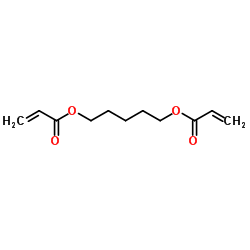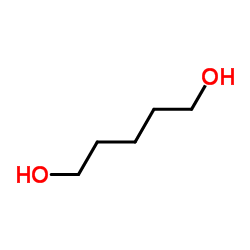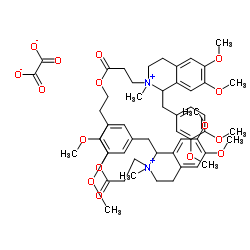36840-85-4
| Name | Pentane-1,5-diyl diacrylate |
|---|---|
| Synonyms |
1,5-Pentanediol Diacrylate
Pentane-1,5-diyl bisacrylate 5-prop-2-enoyloxypentyl prop-2-enoate Pentamethylene Glycol Diacrylate 1,5-Pentanediyl bisacrylate 1,5-Pentamethylene glycol diacrylate 2-Propenoic acid, 1,5-pentanediyl ester 1,5-Bis(acryloyloxy)pentane |
| Density | 1.0±0.1 g/cm3 |
|---|---|
| Boiling Point | 285.1±23.0 °C at 760 mmHg |
| Molecular Formula | C11H16O4 |
| Molecular Weight | 212.242 |
| Flash Point | 134.4±21.0 °C |
| Exact Mass | 212.104858 |
| PSA | 52.60000 |
| LogP | 2.42 |
| Vapour Pressure | 0.0±0.6 mmHg at 25°C |
| Index of Refraction | 1.453 |
|
1,5-Bis(acryloyloxy)pentane (stabilized with MEHQ)
Revision number: 6
SAFETY DATA SHEET Section1. IDENTIFICATION Product name:1,5-Bis(acryloyloxy)pentane (stabilized with MEHQ) Revision number:6 Section2. HAZARDS IDENTIFICATION GHS classification PHYSICAL HAZARDSNot classified HEALTH HAZARDS Skin corrosion/irritationCategory 2 Category 2A Serious eye damage/eye irritation Skin sensitizationCategory 1 Not classified ENVIRONMENTAL HAZARDS GHS label elements, including precautionary statements Pictograms or hazard symbols Signal wordWarning Hazard statementsCauses skin irritation Causes serious eye irritation May cause an allergic skin reaction Precautionary statements: Avoid breathing dust/fume/gas/mist/vapours/spray. [Prevention] Contaminated work clothing should not be allowed out of the workplace. Wash hands thoroughly after handling. Wear protective gloves/eye protection/face protection. IF IN EYES: Rinse cautiously with water for several minutes. Remove contact lenses, [Response] if present and easy to do. Continue rinsing. If eye irritation persists: Get medical advice/attention. IF ON SKIN: Gently wash with plenty of soap and water. If skin irritation or rash occurs: Get medical advice/attention. Wash contaminated clothing before reuse. Other hazards which do notMay cause polimerization. result in classification Section3. COMPOSITION/INFORMATION ON INGREDIENTS Substance/mixture:Substance Components:1,5-Bis(acryloyloxy)pentane (stabilized with MEHQ) Percent:>97.0%(GC) 36840-85-4 CAS Number: 1,5-Bis(acryloyloxy)pentane (stabilized with MEHQ) Section3. COMPOSITION/INFORMATION ON INGREDIENTS Synonyms:1,5-Pentanediol Diacrylate (stabilized with MEHQ) , Pentamethylene Glycol Diacrylate (stabilized with MEHQ) Chemical Formula:C11H16O4 Section4. FIRST AID MEASURES Inhalation:Remove victim to fresh air and keep at rest in a position comfortable for breathing. Get medical advice/attention if you feel unwell. Skin contact:Remove/Take off immediately all contaminated clothing. Gently wash with plenty of soap and water. If skin irritation or rash occurs: Get medical advice/attention. Eye contact:Rinse cautiously with water for several minutes. Remove contact lenses, if present and easy to do. Continue rinsing. If eye irritation persists: Get medical advice/attention. Ingestion:Get medical advice/attention if you feel unwell. Rinse mouth. Protection of first-aiders:A rescuer should wear personal protective equipment, such as rubber gloves and air- tight goggles. Section5. FIRE-FIGHTING MEASURES Dry chemical, foam, water spray, carbon dioxide. Suitable extinguishing media: Unsuitable extinguishing Solid streams of water media: Specific hazards arising This substance may polimerize explosively when heated or involved in a fire. from the chemical:Container may explode when heated. Combat fire from a sheltered position. Precautions for firefighters: Fire-extinguishing work is done from the windward and the suitable fire-extinguishing method according to the surrounding situation is used. Uninvolved persons should evacuate to a safe place. In case of fire in the surroundings: Keep containers cool by spraying with water. Eliminate all ignition sources if safe to do so. Special protectiveWhen extinguishing fire, be sure to wear personal protective equipment. equipment for firefighters: Section6. ACCIDENTAL RELEASE MEASURES Personal precautions,Use personal protective equipment. Keep people away from and upwind of spill/leak. protective equipment and Ensure adequate ventilation. Entry to non-involved personnel should be controlled emergency procedures: around the leakage area by roping off, etc. Environmental precautions: Prevent product from entering drains. Methods and materials for Absorb spilled material in dry sand or inert absorbent before recovering it into a containment and cleaning covered container. In case of large amount of spillage, contain a spill by bunding. up: Adhered or collected material should be promptly disposed of, in accordance with appropriate laws and regulations. Section7. HANDLING AND STORAGE Precautions for safe handling Technical measures:Handling is performed in a well ventilated place. Wear suitable protective equipment. Prevent generation of vapour or mist. Wash hands and face thoroughly after handling. Use a ventilation, local exhaust if vapour or aerosol will be generated. Advice on safe handling: Avoid contact with skin, eyes and clothing. Conditions for safe storage, including any incompatibilities Storage conditions:Keep container tightly closed. Store in a cool and dark place. Store away from incompatible materials such as oxidizing agents. Packaging material:Comply with laws. 1,5-Bis(acryloyloxy)pentane (stabilized with MEHQ) Section8. EXPOSURE CONTROLS / PERSONAL PROTECTION Engineering controls:Install a closed system or local exhaust as possible so that workers should not be exposed directly. Also install safety shower and eye bath. Personal protective equipment Respiratory protection: Vapor respirator. Follow local and national regulations. Hand protection:Protective gloves. Safety glasses. A face-shield, if the situation requires. Eye protection: Skin and body protection: Protective clothing. Protective boots, if the situation requires. Section9. PHYSICAL AND CHEMICAL PROPERTIES Physical state (20°C):Liquid Clear Form: Colour:Very pale yellow - Pale yellow No data available Odour: pH: No data available Melting point/freezing point:No data available Boiling point/range:95°C/0.01kPa Flash point:No data available Flammability or explosive limits: Lower:No data available Upper:No data available Relative density:1.04 Solubility(ies): [Water]No data available [Other solvents] Soluble:Acetone Section10. STABILITY AND REACTIVITY Chemical stability:Polymerization may occur under the influences of heat, light or on contact with polymelization initiators such as peroxides etc. Possibility of hazardous No special reactivity has been reported. reactions: Conditions to avoid:Heat, Light Incompatible materials: Oxidizing agents, Strong acids, Strong bases, Heavy metals Hazardous decomposition Carbon monoxide, Carbon dioxide products: Section11. TOXICOLOGICAL INFORMATION Acute Toxicity:No data available Skin corrosion/irritation: No data available Serious eyeNo data available damage/irritation: Germ cell mutagenicity: No data available Carcinogenicity: IARC =No data available NTP =No data available Reproductive toxicity:No data available Section12. ECOLOGICAL INFORMATION Ecotoxicity: No data available Fish: Crustacea:No data available No data available Algae: Persistence / degradability: No data available No data available Bioaccumulative potential(BCF): 1,5-Bis(acryloyloxy)pentane (stabilized with MEHQ) Section12. ECOLOGICAL INFORMATION Mobility in soil No data available Log Pow: Soil adsorption (Koc):No data available No data available Henry's Law constant(PaM3/mol): Section13. DISPOSAL CONSIDERATIONS Recycle to process, if possible. Consult your local regional authorities. You may be able to burn in a chemical incinerator equipped with an afterburner and scrubber system. Observe all federal, state and local regulations when disposing of the substance. Section14. TRANSPORT INFORMATION Does not correspond to the classification standard of the United Nations Hazards Class: UN-No:Not listed Section15. REGULATORY INFORMATION Safe management ordinance of dangerous chemical product (State Council announces on January 26, 2002 and revised on February 16,2011): Safe use and production, the storage of a dangerous chemical, transport, loading and unloading were prescribed. SECTION 16 - ADDITIONAL INFORMATION N/A |
| Hazard Codes | Xi |
|---|---|
| HS Code | 2916190090 |
|
~75% 
36840-85-4 |
| Literature: Burroughs Wellcome Co. Patent: US5453510 A1, 1995 ; |
|
~59% 
36840-85-4 |
| Literature: Stenlake; Waigh; Dewar; et al. European Journal of Medicinal Chemistry, 1981 , vol. 16, # 6 p. 515 - 524 |
|
~% 
36840-85-4 |
| Literature: GLAND PHARMA LIMITED Patent: WO2010/128518 A2, 2010 ; Location in patent: Page/Page column 7; 10; 11 ; |
|
~% 
36840-85-4 |
| Literature: Popescu, Dragos; Hoogenboom, Richard; Keul, Helmut; Moeller, Martin Journal of Molecular Catalysis B: Enzymatic, 2010 , vol. 62, # 1 p. 80 - 89 |
|
~% 
36840-85-4 |
| Literature: Lee; Kim; Piantadosi; Huang; Geissman Journal of pharmaceutical sciences, 1974 , vol. 63, # 7 p. 1162 - 1163 |
|
~% 
36840-85-4 |
| Literature: Lee; Kim; Piantadosi; Huang; Geissman Journal of pharmaceutical sciences, 1974 , vol. 63, # 7 p. 1162 - 1163 |
| Precursor 5 | |
|---|---|
| DownStream 2 | |
| HS Code | 2916190090 |
|---|---|
| Summary | 2916190090 unsaturated acyclic monocarboxylic acids, their anhydrides, halides, peroxides, peroxyacids and their derivatives。supervision conditions:AB(certificate of inspection for goods inward,certificate of inspection for goods outward)。VAT:17.0%。tax rebate rate:9.0%。MFN tariff:6.5%。general tariff:30.0% |








![2(1H)-ISOQUINOLINEPROPANOIC ACID,1-[(3,4-DIMETHOXYPHENYL)METHYL]-3,4-DIHYDRO-6,7-DIMETHOXY-, 1,5-PENTANEDIYL ESTER, (R*,R*)-(-)-, ETHANEDIOATE structure](https://image.chemsrc.com/caspic/002/64228-84-8.png)